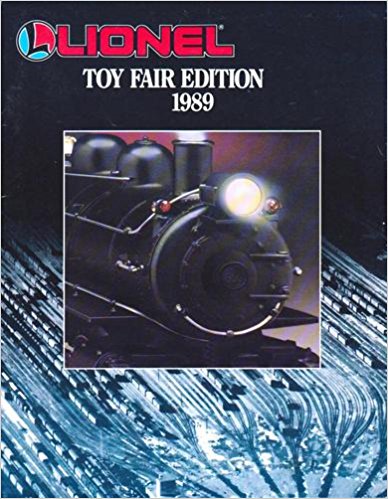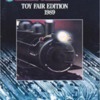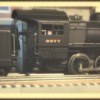I'm looking at a Lionel B-6 switcher, #6-18000. I'm not familiar with this loco since I run post-war stuff. Would it perform well on a post-war tubular track layout ?
Replies sorted oldest to newest
Yes, it works well, that's the only kind of track I use. You can find a great selection of them on Ebay.
Yes, this is just prior to TMCC, probably would be a great runner and a nice addition to your collection. I would think it would negotiate great on 022 switches. Let us know if you if you get one of those neat switchers.
I have had mine since it first came out. It is a very smooth runner. It used much of the original tooling from the 1937 loco (I think that was the year it was introduced). It is a scale model, except for the flanges and couplers. It has puffing smoke, back up light, and the first version of Railsounds. I run mine a lot, even though I have many Legacy locos. Also, it’s drive is similar to the scale Hudson of the 1930’s, which is one of the reasons it runs so smooth. It fits well with post war trains(and prewar since it dates back to then).
Thanks all.
Dan, I bought mine new in 89 and was not happy with the gearing. Guess the thing would run 200 smph. I have a box of brass gears from slot car days and found a pair that would mesh properly. The original gears between the motor shaft and the worm gear shaft were 9T pinion on the motor shaft and a 19T on the worm gear shaft. 2.11 : 1. I can't remember what the tooth count on the gears I replaced the originals with but they raised the ratio to a over 3:1. It made a huge difference in it's ability creep but one problem I had was the original gears are 32 pitch and the slot car gears were 48 pitch (finer teeth) and they tended to whurr a bit louder than I liked so I made a gearbox cover out of brass and played around with different home brewed gear box grease. What I ended up with was STP, Graphite and very fine sawdust. With the gearbox cover in place it is at least as quiet as the original gears. I have an LCRU2 that I am planning to install in it but may have to wait till fall before I can get to it I will make photos and count the teeth on the new gears then. I remember another problem I had was the motor wanted to start running before the E-unit completed pulling the drum into place and when going from neutral to forward It would lurch forward like a drag racer. I cured this by stacking parallel back to back + to - diodes on the leads to the brushes. I don't remember how many are in the chain but I kept adding pairs till the E-unit would completely cycle before the motor had enough voltage to run. With the mods the B6 is the best running conventional loco I have. J
Hey @Former Member -
I love mine, runs fine on my very tight (tubular) tabletop layout with the small switches (O-27 I think). I've taken tons of pictures of mine which can be found here.
They can be found on eBay selling between $140-$300, with an average price of about $220, I saw one once listed for $800 believe it or not.
I'll try to give mine a run tonight and take a video if I get a chance - and update this post if you'd like.
Attachments
I might as well chime in, too. I have one of those B6 switchers that I bought NIB about seven years ago. I use FasTrack, and my tightest curve is 036, but the B6 takes it easily. Smoke and sound are all I could ask for, and it's an excellent runner. All in all, a significant improvement over the original. I'd recommend one to anyone without hesitation.
I guess I will chime in as someone else who is a fan of this locomotive. I have had one for about 15 years. I like the look and mine runs and has enough detail for me. I know the wheel spacing is incorrect and details are missing. Today they can be purchased for what I consider really good prices. There was one recently listed for sale on the Buy/Sell section here for a pretty good price, although I can't remember what that was. May still be listed but I'm sure it is pages back now
Bought a new one on Ebay about 6 weeks ago and very pleased. Think they first came out in 1939 - is geared to run too fast but prewar locos usually ran fast and it works fine on a MTH Z1000 transformer.
I pulled the trigger on a new one listed on Ebay. Got it for $200.00 including shipping. Looking forward to getting it. When we were kids, my brother's loco was the pre-war version. It will be nice having the loco once more, albeit a newer version.
Yeah!
After it arrives please feel free to post a picture or two of it onto the weekly Switcher Saturday!
Enjoy...Rich
They are prone to the plastic axle gear splitting, so test run any you look at buying, or ask if the original gear has been replaced
Dan Padova posted:I pulled the trigger on a new one listed on Ebay. Got it for $200.00 including shipping. Looking forward to getting it. When we were kids, my brother's loco was the pre-war version. It will be nice having the loco once more, albeit a newer version.
Started watching that one last night after reading your thread. Nice grab!
"Dan, I bought mine new in 89 and was not happy with the gearing."
I never owned one, but a friend was considering selling his as he did not like the way it ran. I thought about it as it is historically interesting, but after testing it on my layout, I decided that a 100 smph switcher was not appealing, even historically, for any price he would find acceptable. So, I don't have one.
I can't imagine why they made it that way; the old 700E Hudson was well geared, and was a contemporary. And a better switcher, if it came to that. Did Lionel in the 80's change the B6 gearing? The 80's 785 Hudson will run at calm speeds; I have one.
check out mine.....
Attachments
D500 posted:"Dan, I bought mine new in 89 and was not happy with the gearing."
I never owned one, but a friend was considering selling his as he did not like the way it ran. I thought about it as it is historically interesting, but after testing it on my layout, I decided that a 100 smph switcher was not appealing, even historically, for any price he would find acceptable. So, I don't have one.
I can't imagine why they made it that way; the old 700E Hudson was well geared, and was a contemporary. And a better switcher, if it came to that. Did Lionel in the 80's change the B6 gearing? The 80's 785 Hudson will run at calm speeds; I have one.
I am surprised to read this. I though the 18005 was mostly just the prewar 227 switcher with a modern motor and eunit. Many of the parts are interchangeable. Following is a quote from a previous post regarding the gearing on the 227.
"Ted, the motor pinion has 9 teeth, the bull on the worm shaft has 19 teeth. That gives a ratio of 2.11 to 1. The worm is a 3 lead worm. The worm wheel has 21 teeth. That would give a gear ratio of 7 to 1. The overall ratio is 14.77 to1. So the armature would make about 15 turns to get the wheels to make one full revolution... These 227 series locos run noticeable slower than most post war locomotives do."
Haha thanks @David Johnston, you saved me the trouble of searching for that post!
Agree with David, the final gear ratio of 14.77 is quite a bit slower than a "regular" postwar steam loco, which are usually geared around 10:1. Of course the scale Hudson is geared at 18:1, but it has MUCH larger driving wheels. Most people don't regard the 773 as a fast runner.
One mystery that I never solved... The switcher was introduced in '39 and that year's catalog touts the gear ratio as "20:1". Is this just marketing puffery, or did Lionel start out with a TWO-lead worm (which would have been 22:1), and then switch to the faster three-lead worm in the 1940s? I always look for scale switcher mechanisms in junk boxes at York, trying to prove this one way or another. Where's Bruce Greenberg when you need him? :-)








